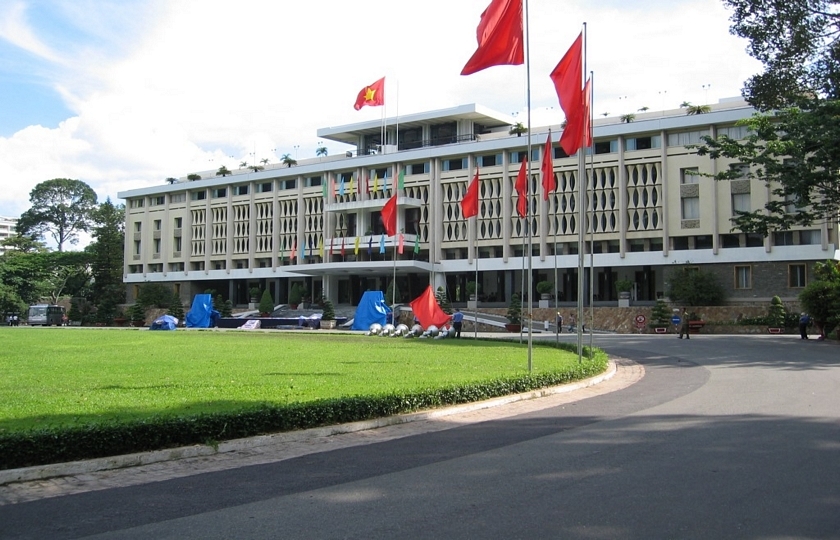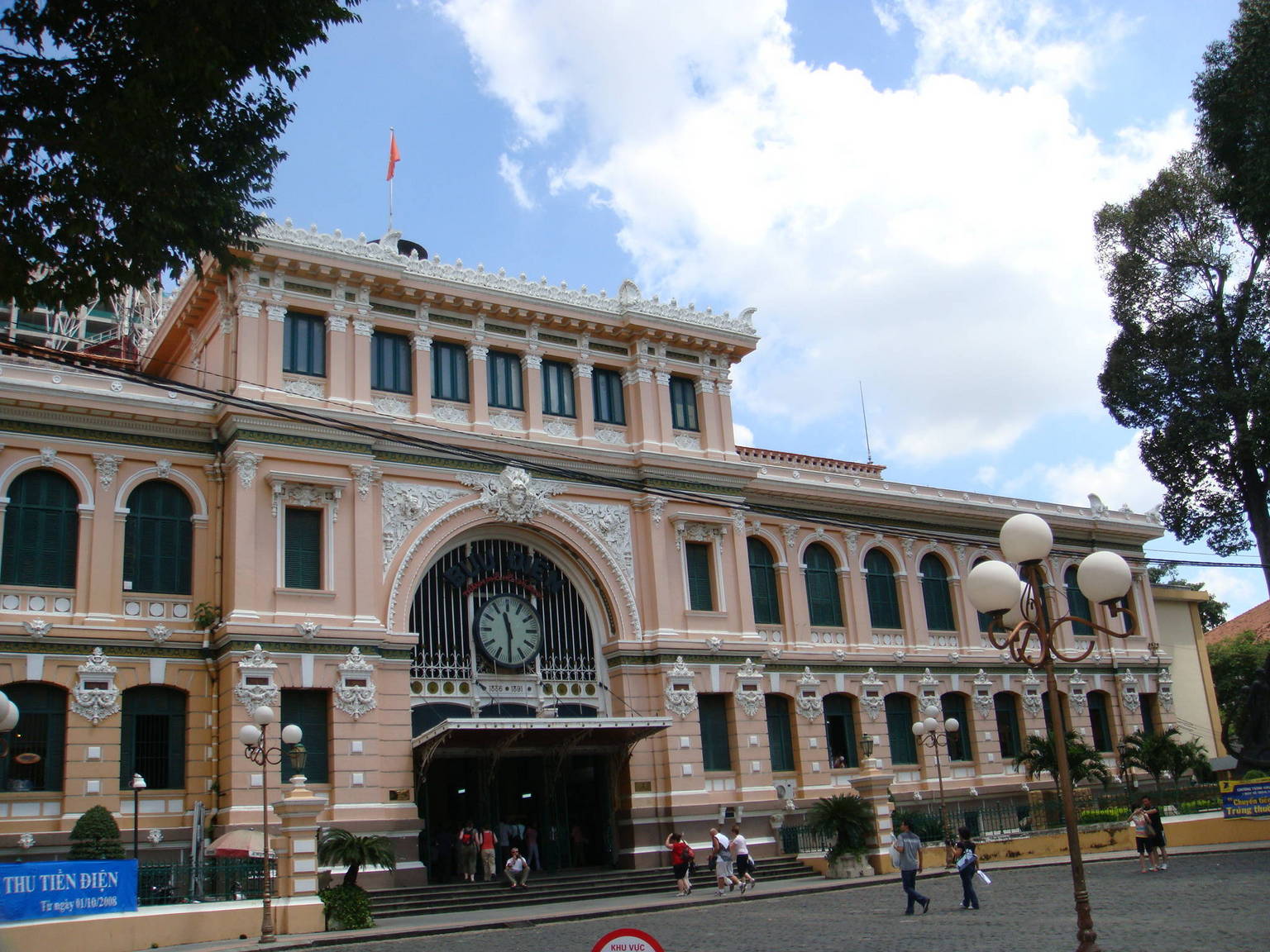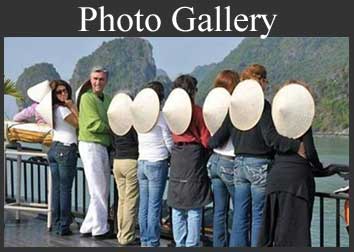Reunification Palace
Reunification Palace (the formerly Independence Royal Palace). Distinctly 1970s architecture and fine grounds make this at least worth a walk by. The iconic Vietnam War picture of a tank crushing its way through the iron gates of the palace on liberation day was taken here.

It was designed by Ngo Viet Thu as the home and workplace of the President of South Vietnam during Vietnam War and the site of the official handover of power during the Fall of Saigon on April 30, 1975. It was then known as Independence Palace, and an NVA tank crashed through its gates, as recorded by Neil Davis.
In 1858, France launched the first attack in Danang, starting its invasion of Vietnam. In 1867, France completed its conquest of Nam Bo (Cochinchina). To consolidate the newly-established colony in Nam Bo, on 23 February 1868, Lagrandière, Governor of Nam Bo, held the first building stone ceremony to start the construction of a new palace in replacement of the old wooden palace built in 1863. The new palace was designed by Hermite who was also the architect of Hong Kong City Hall. That first cubic stone came from Bien Hoa, 50cm each edge with holes containing French gold and silver coins with Napoleon III images.
Reunification Palace covered on an area of 12 hectares, including a palace with the facade of 80 meters in width, a guest-chamber capable to accommodate 800 persons, with a surroundings gardens covered by green trees and grasses. Most of the building materials were imported from France. Due to the Franco-Prussian War of 1870, the construction was behind the schedule. Not till 1873 was this palace completed. The palace was named Norodom Palace after the name of the king of Cambodia – King Norodom (1834 – 1904)). From 1871 to 1887, the palace was for the use of the French Governor of Nam Bo, therefore it was referred to as Governor’s Palace. From 1887 to 1945, all Governors-General of French Indochina used this palace as their residence and office. The palace in this period was referred to as Governor General Palace. The office of the Nam Bo people Governors was relocated to a nearby villa.
On March 9, 1945, Japan defeated France and replaced France in French Indochina. Norodom Palace became the office of Japanese colonists in Vietnam. In September 1945, Japan surrendered to the Allied forces in World War II, France returned to the Nam Bo, Norodom Palace restored its position as the office of French colonists in Vietnam.
On May 7, 1954, France surrendered to Vietnamese troop (Viet Cong) after its defeat in the Battle of Dien Bien Phu. France agreed to sign the Geneva Accords and withdrew its troops from Vietnam. According to the accords, Vietnam would be divided for two years until 1956 with the 17th Parallel as the temporary border line when a vote based on universal suffrage would be held to establish a unified Vietnamese government. North Vietnam was under the control of a communist government Democratic Republic of Vietnam while South Vietnam was under the anti-communist Republic of Vietnam. On 7 September 1954, Norodom Palace was handed over to the prime minister of the Republic of Vietnam Ngo Dinh Diem and a representative of French government, General Paul Ely.
In 1955, Ngo Dinh Diem overthrew Bao Dai, the head of the Republic of Vietnam in a referendum. Ngo Dinh Diem became President of the Republic of Vietnam and renamed the Norodom Palace Independence Hall. From this time the palace became the Presidential Palace. According to Fengshui belief, this palace is located in a dragon’s head, therefore it was also referred to as Dragon's Head Palace.
On 27 February 1962, two pilots of Army of the Republic of Vietnam Nguyen Van Cu and Pham Phu Quoc flew two A-1 Skyraider aircraft and bombed the Hall in what was known as 1962 South Vietnamese Presidential Palace bombing, as a result almost all left wing of the Hall was destroyed. Considering that it was almost impossible to restore the Hall, Diem ordered to have it removed and rebuilt a new one on the site of the original palace. The new palace was constructed according to the design by Ngo Viet Thu, a Vietnamese architect who won the First Grand Prize of Rome (Grand Prix de Rome) in 1955, the highest recognition of the Beaux-Arts school in Paris. He was also a laureate of Rome Architecture Award.
The construction of the new Independence Hall started on 1 July 1962. In the meanwhile, Ngo Dinh Diem moved to Gia Long Palace (today this is the Ho Chi Minh City Museum). However Ngo Dinh Diem had no chance to see the completed hall as he and his brother Ngo Dinh Nhu were assassinated in a coup D’etat by the opposition alliance on 2 November 1963. The completed hall was inaugurated on 31 October 1966 and was chaired by the chairman of the National Leadership Committee, Nguyen Van Thieu. The Independence Hall became the Presidential Palace again and was Thieu’s home and office from October 1967 to 21 April 1975.
On 8 April 1975, Nguyen Thanh Trung, a pilot of the South Vietnam Air Force (but in fact he was a communist spy) flew F5E aircraft, originated from Bien Hoa, bombed the Hall but caused no significant damages. At 10:45 am 30 April 1975, a tank of the North Vietnamese Army hit the main gate, ending the Vietnam War. In November 1975, after the negotiation convention between the communist North Vietnam and communist South Vietnam was successful, in memory of that event, the Provisional Government of the Republic of South Vietnam renamed the hall Reunification Hall.




.jpg)





